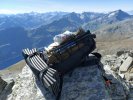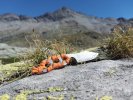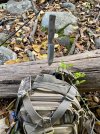-
The BladeForums.com 2024 Traditional Knife is ready to order! See this thread for details: https://www.bladeforums.com/threads/bladeforums-2024-traditional-knife.2003187/
Price is$300$250 ea (shipped within CONUS). If you live outside the US, I will contact you after your order for extra shipping charges.
Order here: https://www.bladeforums.com/help/2024-traditional/ - Order as many as you like, we have plenty.
You are using an out of date browser. It may not display this or other websites correctly.
You should upgrade or use an alternative browser.
You should upgrade or use an alternative browser.
Photos Blades on Hikes
- Thread starter dogstar
- Start date
Ironbut
Gold Member
- Joined
- Mar 1, 2016
- Messages
- 8,218
I certainly don't need another knife, but with a nice 3 1/4" blade & under 2 oz, those Bugouts are really tempting.Enjoyed a nice hike today along the Ohio & Erie Towpath Trail in the Cuyahoga Valley National Park.
View attachment 2012113
View attachment 2012114
View attachment 2012115
(Edit: Damn spellcheck!)
Last edited:
- Joined
- Nov 27, 2021
- Messages
- 449
I certainly don't need any more knives either, and yet I just keep buying them...I certainly don't need another knife, but with a nice 3 1/4" blade & under 2 oz, those Bugouts are fully tempting.
jmh33
Gold Member
- Joined
- Mar 16, 2003
- Messages
- 10,985
jmh33
Gold Member
- Joined
- Mar 16, 2003
- Messages
- 10,985
- Joined
- Oct 5, 2015
- Messages
- 1,892
Can I ask for info about the blade? I like everything about it!
- Joined
- Oct 5, 2015
- Messages
- 1,892
This thread makes me want to grow a beard (I blame Knives&Lint) and get lost in the woods. Moving to BC soon; that should help!
miltmaldo
Gold Member
- Joined
- Feb 5, 2012
- Messages
- 3,584
Can I ask for info about the blade? I like everything about it!
Its a Spyderco Endura with Allen Putnam Aluminum scales .
- Joined
- Oct 5, 2015
- Messages
- 1,892
Oh sorry, I was actually asking about the fixed blade you posted at the top of the page.Its a Spyderco Endura with Allen Putnam Aluminum scales .
miltmaldo
Gold Member
- Joined
- Feb 5, 2012
- Messages
- 3,584
Lol that’s a Survive GSO 4.1 it’s the old style .Oh sorry, I was actually asking about the fixed blade you posted at the top of the page.
The Zieg
Gold Member
- Joined
- Jan 31, 2002
- Messages
- 4,982
I love this thread! I think there is one similar in the Traditional subforum, so I think I'll cross post.
I'm in New Mexico this week and getting in a bit of walking. Now who was the BF member way back who swore by an Opinel and a multitool solving all his problems? A N°10 and a SOG Paratool are working for me right now!

Zieg
I'm in New Mexico this week and getting in a bit of walking. Now who was the BF member way back who swore by an Opinel and a multitool solving all his problems? A N°10 and a SOG Paratool are working for me right now!

Zieg
Last edited:
The Zieg
Gold Member
- Joined
- Jan 31, 2002
- Messages
- 4,982
More NM . . .I love this thread! I think there is one similar in the Traditional subforum, so I think I'll cross post.
I'm in New Mexico this week and getting in a bit of walking. Now who was the BF member way back who swore by an Opinel and a multitool solving all his problems? A N°10 and a SOG Paratool are working for me right now!

Zieg



Zieg
I'm not a multitool guy... yet. If I keep hanging around here, I'm sure that day is coming.I love this thread! I think there is one similar in the Traditional subforum, so I think I'll cross post.
I'm in New Mexico this week and getting in a bit of walking. Now who was the BF member way back who swore by an Opinel and a multitool solving all his problems? A N°10 and a SOG Paratool are working for me right now!

Zieg
BTW, beautiful place, hope to visit NM some day!
The Zieg
Gold Member
- Joined
- Jan 31, 2002
- Messages
- 4,982
My multitool use comes and goes but give one a try and you'll be pleasantly surprised. I usually only carry it around the farm so I can get small tasks done quickly. This was mostly an homage to that BF member whose name I've forgotten.I'm not a multitool guy... yet. If I keep hanging around here, I'm sure that day is coming.
Zieg
Some chit chat about poles....Good point. I really should, but I haven't yet. Well, that is to say I don't bring poles, I do often find a stick to use while I'm out there and shave it down for a single walking stick. So I do see the benefit of them, especially when heading back down steep terrain. I'm considering going out this week (plans still up in the air) to a spot that's already snow packed and will undoubtedly also be icy, and I've already decided that I'm gonna finally bring some poles along for that one just for good measure.
There was a time where the so called trekking poles (the colapsible ones) were a rare sight in the outdoors and mostly only related to heavy hauls between camps during high altitude expeditions (Hymalaya) or polar exploration requiring pulling pulkas on skis or snowshoes.
However, things have changed for the better (IMHO) and now you can see them all over the place. Wooden poles are ok if you plan on smacking wild creatures on the head with them or pole-vault-jump style stunts. For anything else, trekking poles are vastly supperior. They are lighter, lengh adjustable, comfortable grips and include a leash (not all models) and baskets (smaller for summer, bigger for winter/snow).
They allow you to use your upper body strength when carrying a heavy pack, save your knees when going downhill and are a must when in deep snow (snowshoes or skis).
The only two situations when I don't carry them is when approaching a climb if I am coming down a different way (so I don't have to carry them in the pack while climbing) or when I carry basically nothing (only a Camelback) because I will probably be in trainners and running.
I strongly suggest them for anyone who wants to go outdoors. And you don't need to get uber technical when choosing them. It is easy to get lost between two section / three section, aluminum/carbon fiber, adjustable/fixed length, etc... And you can spend as much as you want.
Mikel
GAGL
Kenny’s Alt Account
- Joined
- Jan 1, 2016
- Messages
- 6,680
Poles rule. I used to be 'no ploes' but read about weight distribution and other positive effects.
Poles make hiking much easier/safer/faster, especially when you're going downhill.
I got a pair of Black Diamond Distance Carbon Z poles, they weigh around 9.8oz/280g

Favorite knife for hiking is my trusty Fred Perrin neck bowie.

Poles make hiking much easier/safer/faster, especially when you're going downhill.
I got a pair of Black Diamond Distance Carbon Z poles, they weigh around 9.8oz/280g

Favorite knife for hiking is my trusty Fred Perrin neck bowie.

Grateful
Gold Member
- Joined
- Oct 5, 2002
- Messages
- 4,554
The Zieg
Gold Member
- Joined
- Jan 31, 2002
- Messages
- 4,982
Yes, I believe so! I loved those posts.
Zieg
I agree that trekking poles are better than single poles for making the miles easier on your body. However, the single staff is not without its merits. A walking staff is as old as time. I made mine out of a replacement broomstick from the hardware store; it weighs 9.3 oz. That is carbon fiber territory. You can snap it over your knee, but for its intended purpose, it is plenty strong. There are no locking joints to break. As a solid piece of wood, I don't worry about whacking aside branches encroaching on the trail. I use mine to set up a tarp as well.Some chit chat about poles....
There was a time where the so called trekking poles (the colapsible ones) were a rare sight in the outdoors and mostly only related to heavy hauls between camps during high altitude expeditions (Hymalaya) or polar exploration requiring pulling pulkas on skis or snowshoes.
However, things have changed for the better (IMHO) and now you can see them all over the place. Wooden poles are ok if you plan on smacking wild creatures on the head with them or pole-vault-jump style stunts. For anything else, trekking poles are vastly supperior. They are lighter, lengh adjustable, comfortable grips and include a leash (not all models) and baskets (smaller for summer, bigger for winter/snow).
They allow you to use your upper body strength when carrying a heavy pack, save your knees when going downhill and are a must when in deep snow (snowshoes or skis).
The only two situations when I don't carry them is when approaching a climb if I am coming down a different way (so I don't have to carry them in the pack while climbing) or when I carry basically nothing (only a Camelback) because I will probably be in trainners and running.
I strongly suggest them for anyone who wants to go outdoors. And you don't need to get uber technical when choosing them. It is easy to get lost between two section / three section, aluminum/carbon fiber, adjustable/fixed length, etc... And you can spend as much as you want.
Mikel
In terms of physical benefits, you still can engage your upper body to push yourself along. I regularly switch sides unless one leg is more fatigued or injured. It also keeps my hands from getting numb on a long hike because they are holding onto something. You can place your hand anywhere along the staff to adjust for uphill and downhill. You can also change the cadence of your plant, from the natural 1-2-3-4, to 1-2-3, or 1-2. I increase the cadence as the hill gets steeper. For really steep hills I use both hands and "paddle" myself uphill. It's amazing how much push you can get. If you are really bored, you can see what I'm talking about here:


